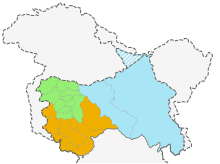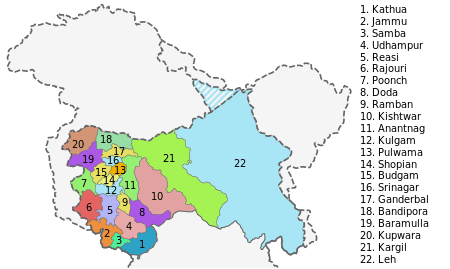1947 Jammu massacres

In September-November 1947 in the Jammu region of the princely state of Jammu and Kashmir, a large number of Muslims—estimated by some sources to as many as 200,000—were massacred and others driven away to West Punjab. The killings were carried out by extremist Hindus and Sikhs, aided and abetted by the forces of the Dogra State headed by the Maharaja Hari Singh.[1][2][lower-alpha 1] A team of two 'Englishmen' jointly commissioned by the governments of India and Pakistan investigated seven major incidents of violence between 20 October – 9 November 1947, totalling 70,000 deaths.[4] Senior Jammu journalist Ved Bhasin estimated the total deaths to be around 100,000.[5]
As a result, at the fall of 1947, more than 300,000 Jammu refugees had reportedly arrived in the Gujranwala and Sialkot regions of Pakistan due to these massacres. Observers state that Hari Singh’s aim was to alter the demographics of the region by eliminating the Muslim population and thereby gain power to continue his rule.[6][7]
Mahatma Gandhi also commented on the situation in Jammu on 25 December 1947 in his speech at a prayer meeting at New Delhi : “The Hindus and Sikhs of Jammu and those who had gone there from outside killed Muslims. The Maharaja of Kashmir is responsible for what is happening there…A large number of Muslims have been killed there and Muslim women have been dishonoured.”[8]
See also
Note

- ↑ To quote a 10 August 1948 report published in The Times:
"237,000 Muslims were systematically exterminated – unless they escaped to Pakistan along the border – by the forces of the Dogra State headed by the Maharaja in person and aided by Hindus and Sikhs. This happened in October 1947, five days before the Pathan invasion and nine days before the Maharaja’s accession to India."
The number of 237,000 was out of 411,000 Muslims said to have lived in the 'eastern Jammu' province, comprising the districts of Jammu (modern Jammu and Samba districts), Udhampur (modern Ramban, Udhampur, Doda and Kishtwar districts), Kathua, and the eastern part of the Reasi district (modern Reasi district). No calculations for the exact figure were given and the figure was not broken down into deaths and escapes. The 'Special Correspondent' that authored the report is later identified as Frederick Paul Mainprice, the former Assistant Political Agent of the Gilgit Agency, who subsequently worked for the Pakistan government.[3]
References
- ↑ Naqvi, Saeed (2016), "The killing fields of Jammu: How Muslims become a minority in the region", Being the Other: The Muslim in India, Aleph Book Company, ISBN 978-93-84067-76-2
- ↑ Snedden, Christopher, "What happened to Muslims in Jammu? Local identity, '"the massacre" of 1947' and the roots of the 'Kashmir problem'", South Asia: Journal of South Asian Studies, 24 (2): 111–134, doi:10.1080/00856400108723454
- ↑ Snedden, Kashmir: The Unwritten History 2013, pp. 55, 330.
- ↑ Snedden, Kashmir: The Unwritten History 2013, pp. 52–53.
- ↑ Ahmad, Khalid Bashir (5 November 2014), "circa 1947: A Long Story", Kashmir Life, retrieved 11 October 2016
- ↑ Chattha, Partition and its Aftermath 2009, pp. 179-180.
- ↑ Noorani, A.G. (25 February 2012). "Horrors of Partition". Frontline. 29 (04).
- ↑ The second assassination of Gandhi? by Ram Puniyani. pp. 91, 92.
Document Twenty.
Bibliography
- Chattha, Ilyas (2011), Partition and Locality: Violence, Migration and Development in Gujranwala and Sialkot 1947-1961, Oxford University Press, ISBN 9780199061723
- Chattha, Ilyas Ahmad (September 2009), Partition and Its Aftermath: Violence, Migration and the Role of Refugees in the Socio-Economic Development of Gujranwala and Sialkot Cities, 1947-1961 (PDF), University of Southampton, retrieved 2016-02-16
- Snedden, Christopher (2013) [first published as The Untold Story of the People of Azad Kashmir, 2012], Kashmir: The Unwritten History, HarperCollins India, ISBN 9350298988
External links
- Genocide of Muslims, Jammu 1947, Kashmir Media Service, undated.